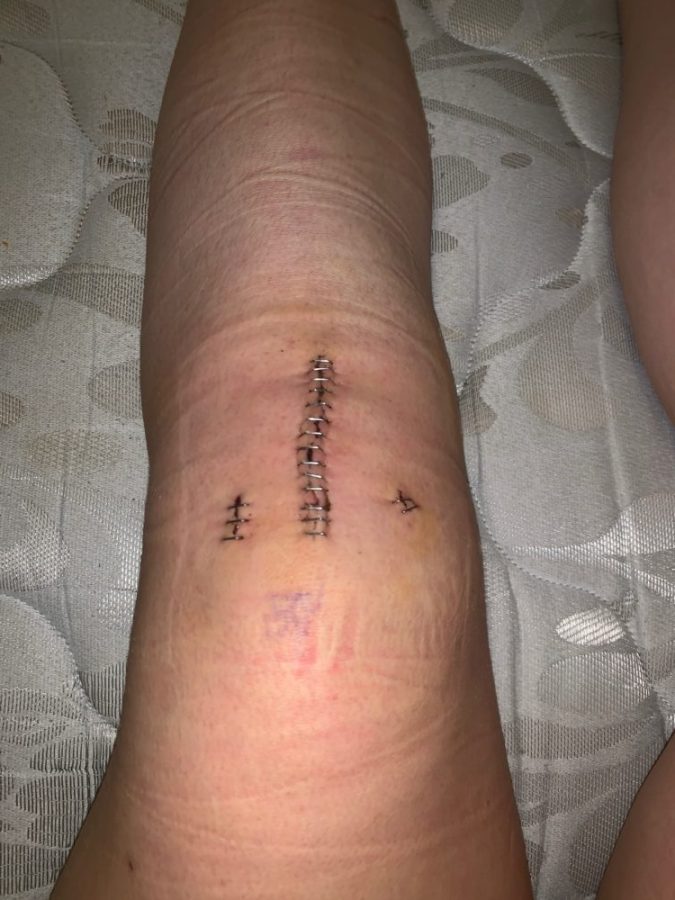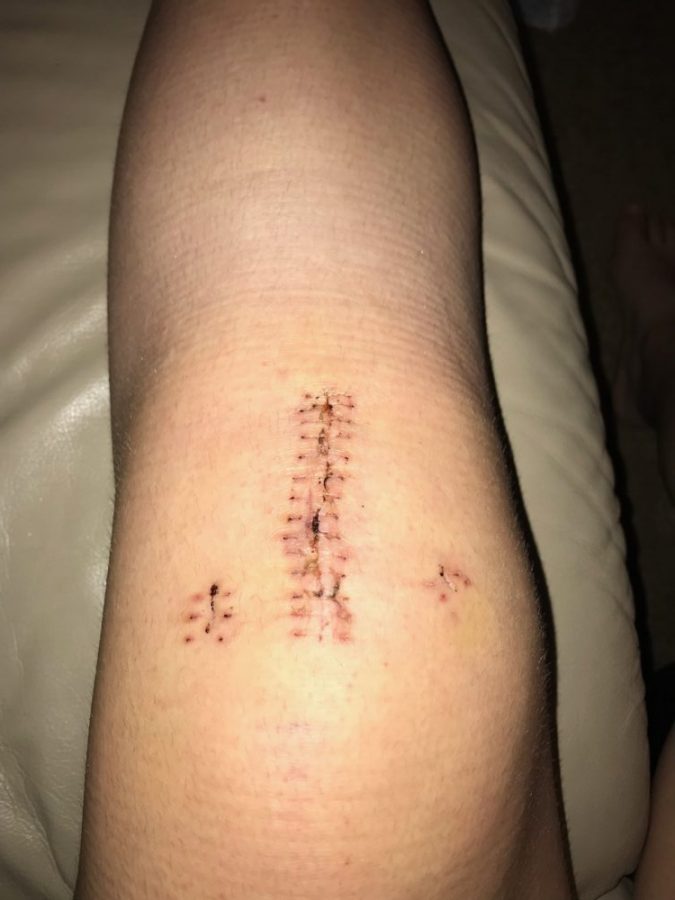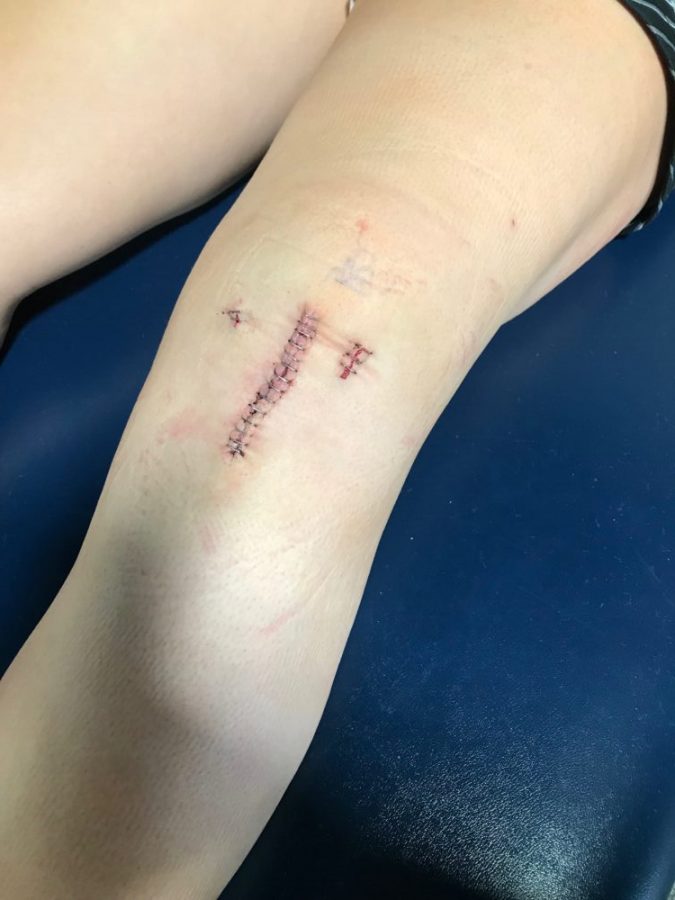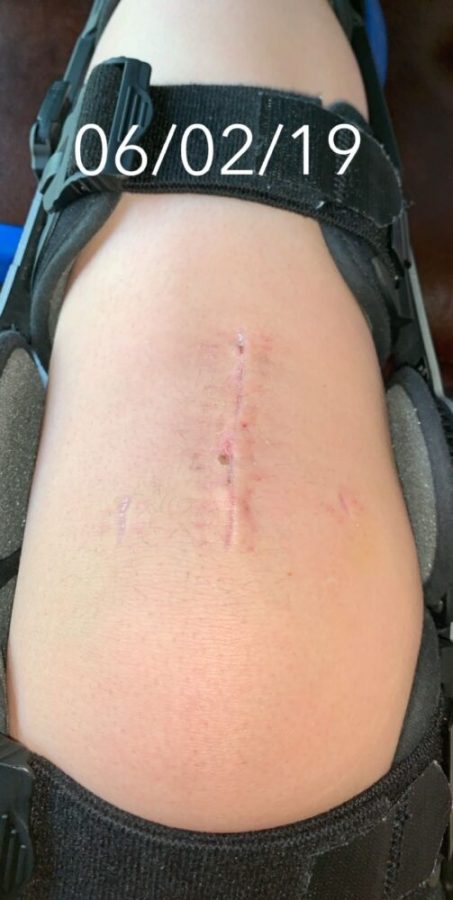A basketball player lands on her feet after rebounding the ball; an awkward landing and a painful pop gives her the impression that something is off; something is wrong. Her knee began to swell, and she no longer can continue to play: all the result of an injury, the word athletes try to avoid at all costs.
Whether it be through shin guards, ankle braces or mouth guards, an injury can cost an entire sports season or money down the drain, especially worrisome for those navigating the waters of contact sports.
For senior Savanah Cunneen, April 15 was just an ordinary day. She woke up, went to school and then geared up for her soccer game: her typical routine. It was junior year, and she had high hopes for the season ahead of her and looked forward to her varsity potential, especially the post season tournaments and goals for a district title. However, all of that would change.
The Bruins were out of class early for the home game that Monday afternoon in preparation for the matchup. Cunneen could only recall a single thought chasing down an opposing player before the moment that completely altered her season, “She’s not going to score, and we’re not losing this game.”
Then, her leg locked up and popped. She walked off the painful feeling but immediately knew something wasn’t right. Afterwards, the unnerving hunch of a critical injury chewed away at her, and she visited Dr. Byron Tarbox, a surgeon for the Columbia Orthopedic Group. Going into the appointment, Cunneen only felt the nerves throughout her body, a terrible, nauseating feeling.
Unfortunately, the meeting only brought bad news: an ACL tear, the anterior cruciate ligament. She then found out that she had torn one of the major ligaments in her knee and that meant up to six months or more of recovery. Cunneen could only cry: soccer was over for the rest of the year, and her junior year down the drain.
Next, she began to prepare herself for the long process ahead.
“It was all really hard. The first four weeks post surgery I wasn’t able to put any weight on my left leg because of the torn meniscus they found in surgery,” Cunneen said. “[This] was really hard because I needed help to do super basic stuff.”
On May 9, Cunneen underwent the surgery to repair the torn ligament, a surgery that usually takes less than two hours, according to UCSF Health. Post surgery, she was unable to get up on her own for about two weeks and had to use a wheelchair her first day back at school. Then, Cunneen was on crutches for four more weeks barring no weight and then for another half a week, when she started actually walking again. All of this and she still wasn’t fully recovered. She needed physical therapy to regain her strength, which would last into the summer.
An ACL tear or sprain occurs with a sudden change in direction or pivot against a locked knee which can happen at any point in one’s life and is particularly common in athletes, according to MedicineNet. Additionally, women are more likely to tear their ACL because of differences in anatomy and muscle function. From this angle, school sports can be considered dangerous, Cunneen said.
“But with any sport,” Cunneen said, “especially contact sports, you are putting yourself out there and anything could happen no matter what precautions there are.”
Because of this, an athlete has to go into their season prepared for whatever may happen, including injuries and even season ending ones like an ACL tear.
A recent study confirmed that ACL injuries in children and adolescents are on the rise, according to the Children’s Hospital of Philadelphia. The authors found a 2.3 percent annual increase from 1994 to 2013 in the number of ACL tears in patients six to 18 years old. Also, the highest risk of injury was for female soccer players. Shaon Fry, Peak Performance co-owner and physical therapist, contributes this data to the increase in students participating in high school athletics as well as the higher level of intensity. Also, he said the number of kids he sees recovering from ACL tears varies from year to year. Right now, Fry believes he’s training three or four, and all of them struggling with the same post-op symptoms.
“There’s usually a bunch of pain, which is not great. They’re having trouble getting around; crutches are always miserable,” Fry said. “They’ve got the swelling; they’ve got the pain. . . There’s the psychological part, too. They’re not happy because they’re not competing, and they’re not with their teammates. So, it’s hard. It’s a hard thing to deal with.”
Cunneen knows of at least seven other student-athletes who have all torn their ACL during their seasons, one of which includes current junior Kate Linnemeyer. For her, Feb. 7, 2018, upturned her sophomore basketball season.
“I tore my ACL at basketball practice when I was back cutting to the basket,” Linnemeyer said. “I jumped up in the air to catch the ball and I came down and landed on someone’s foot.”
Both Linnemeyer and Cunneen struggled with the long term recovery. In particular, Linnemeyer felt as though she was “behind everyone else” she was competing with before tearing her ACL.
Recovery and rehabilitation is a long process. When one has an ACL reconstruction, a new ligament is created and held in the knee with screws or other fixation devices, according to Verywell Health. Then, the ACL has to heal in this position which requires the injured individual to keep his or her knee straight for an extended period of time. After utilizing crutches or other aids, one also has to go to physical therapy in order to regain lost strength and mobility.
“We try to help with function; we usually try to help increase their range of function, increase their strength, get them back on their feet,” Fry said. “You got the training. You have to get the range of motion back. You have to help them work on gains and their walking. You have to get rid of the swelling and keep working on function, as far as being able to squat and jump and run and things of that nature.”
Linnemeyer said she attended Peak Performance for nearly four and a half months until she was cleared to continue athletics and other activities. Injuries aren’t only a setback on the field, however. The care, many times, can punch a hole in the wallet, as well.
For patients not covered by health insurance, the cost of ACL surgery ranges from just under $20,000 to $50,000, according to Costhelper Health. For those covered by insurance costs, it can range from $800 to $3,000 or more. On top of that, physical therapy sessions cost money depending on whether or not an injured athlete is covered by health insurance. Subject to the person, these costs can add up and may become a real deficit. To avoid the consequences of injury, not just an ACL tear, there are many precautions student athletes can take ahead of time as well as during their seasons.
“I would say try to get some rest when you can and then probably try to come into your season [fit], you want to make sure that you’re flexible and strong and ready to go,” Fry said. “But, yeah, probably rest. I tell my athletes that if you get hurt the first thing you need to do is get some ice on it.”
Linnemeyer also believes stretching and pre-game preparation is crucial to avoiding injury, something she now understands after February.
“I think that taking warm ups and stretching seriously is very important,” Linnemeyer said. “Without proper stretching, it is so easy for people to get injured and if coaches enforce stretches during warmups, that will help prevent injuries and less people would get hurt in school sports.”
Although it seems easy to try and prevent the injury, the problem is inevitable as nearly two million injuries are accounted for per year for high school student athletes, according to STOP Sports Injuries. Both Cunneen and Linnemeyer leaned on friends and flexible teachers in order to survive their second semesters after missing so much school. It was important for both of them to stay on top of schoolwork.
“Make sure you talk to your teachers before you have surgery so you can make a plan about the schoolwork you will be missing,” Linnemeyer said. “Also, take advantage of your school trainer because without them my recovery would have taken a lot longer than four and a half months.”
Tearing an ACL is a long, stressful process and student athletes are struggling with not only the physical disability, but the mental one as well. Cunneen supports those currently suffering through the process and said they can come back even stronger next year.
“This experience is going to tell you a lot about yourself. It really shows how hard you are willing to work for it,” Cunneen said. “I’d also say that all emotions are expected, but you can’t stay mad forever because there’s no way you can move on and get better if you’re continuing to sulk in the past.”
What do you think about ACL tears and the safety of school sports? Let us know in the comments below!

























































































